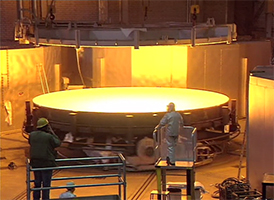Since the manufacture of the 5 m diameter mirror of the Mount Palomar Observatory in 1939, because of their gross mass exceeding 40 tons, the mirrors of the large telescopes have been hollowed out, which allowed them to be lightened by 50 %. But beyond 5 meters, it becomes very difficult to manufacture them in one piece because of the many problems they involve (polishing, constraints, etc.) and transport them by road becomes practically impossible. Opticians have therefore turned to new technologies.
Since the 1990s, all major telescopes have fragmented or ultrathin mirrors. This technology, if it is coupled to an azimuthal mount is particularly simple to implement. The gains in both weight and financial cost convinced the sponsors that telescopes 30 or 40 meters in diameter and over were not a chimera of opticians.
Jerry Nelson’s telescopes (1944-2017), for example, contain multiple mirrors, which are easier to build, the whole being ten times lighter than a single monolithic mirror. The respect of the optimal curvature is entrusted to a computer as the control of the cylinders is complex.
One of Jerry Nelson’s greatest successes are the two 10-meter diameter Keck I and Keck II twin telescopes installed at the top of the Mauna Kea crater on the island of Hawaii, inaugurated in 1991. In both cases, it is a Newton-Cassegrain telescope whose opening ratio is between f/1.75 (hyperbolic) and f/25. The main mirror consists of 36 small hexagonal mirrors each measuring 1.8m from one end to the other. And although these telescopes weigh 300 tons, they work with a nanometer accuracy. The dome is as tall as an 8-storey building.
Keck telescopes are 4 times brighter than Mount Palomar. Their construction, supported by the W.M. Keck Foundation, cost more than $140 million ($225 million discounted). When equipped with adaptive optics (see below) and operate in interferometry, their resolution is equivalent to that of a mirror 85 m in diameter!
These two telescopes are installed near the two Gemini telescopes each equipped with a monolithic mirror 8.1m in diameter covered with a special silvering optimized to reflect more than 99% of the light and reject more than 99% of the infrared radiation.
That said, the greatest success of Jerry Nelson but which he will not see the outcome is the TMT 30 m in diameter (see below).

Another design proposed by the American Roger Angel of the Mirror Laboratory of the Steward Observatory of the University of Arizona replaces the mass of glass with a recessed structure six times lighter in honeycombs. This is the structure adopted for the 6.5m monolithic MMT telescope installed atop Hopkins Mountain in Arizona in 1996. It replaces the multi-mirror structure that was installed in 1979. Its next challenge was a 8.4m mirror. diameter. Today he is thinking of building mirrors for the space consisting of a membrane with a radius of 800m!

cids
asdf
skill issue ngl
Ah heck, reading an essay to download some shit.
i love pahe
Ok how do I download now
mfs